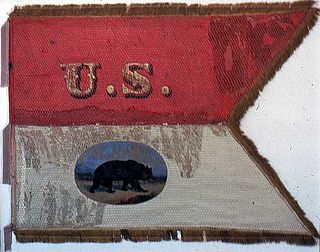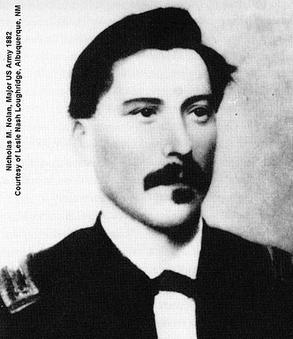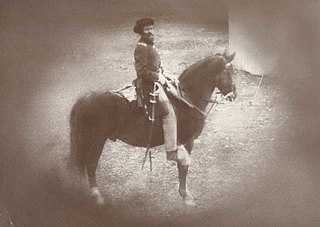4th Michigan Cavalry Regiment was a regiment of cavalry in the Union Army during the American Civil War fighting in the western front as part of the Army of the Cumberland. It was noted as being the regiment that captured the fleeing President of the Confederate States of America, Jefferson Davis, as the Confederacy collapsed in the spring of 1865.

The 2nd Massachusetts Volunteer Cavalry Regiment was a regiment of cavalry troops in the Union army during the American Civil War. It consisted primarily of men from the states of California and Massachusetts, and served in the Eastern Theater, despite its western roots.
The 5th West Virginia Cavalry Regiment was a cavalry regiment that served in the Union Army during the American Civil War.
The 6th Indiana Infantry Regiment was an infantry regiment from the State of Indiana that served in the Union Army during the American Civil War. This regiment was the senior Indiana regiment of the Civil War, as it was numbered first in sequence after the five Indiana volunteer regiments which had served in the Mexican–American War. The regiment was originally mustered-in for a three-month period of service between April and August 1861, but after its initial term of service had expired it was re-formed in September 1861 for a further three-year period, before being mustered out in September 1864.
Galvanized Yankees was a term from the American Civil War denoting former Confederate prisoners of war who swore allegiance to the United States and joined the Union Army. Approximately 5,600 former Confederate soldiers enlisted in the United States Volunteers, organized into six regiments of infantry between January 1864 and November 1866. Of those, more than 250 had begun their service as Union soldiers, were captured in battle, then enlisted in prison to join a regiment of the Confederate States Army. They surrendered to Union forces in December 1864 and were held by the United States as deserters, but were saved from prosecution by being enlisted in the 5th and 6th U.S. Volunteers. An additional 800 former Confederates served in volunteer regiments raised by the states, forming ten companies. Four of those companies saw combat in the Western Theater against the Confederate Army, two served on the western frontier, and one became an independent company of U.S. Volunteers, serving in Minnesota.

The area that eventually became the U.S. state of Montana played little direct role in the American Civil War. The closest the Confederate States Army ever came to the area was New Mexico and eastern Kansas, each over a thousand miles away. There was not even an organized territory using "Montana" until the Montana Territory was created on May 26, 1864, three years after the Battle of Fort Sumter. In 1861, the area was divided between the Dakota Territory and the Washington Territory, and in 1863, it was part of the Idaho Territory.
The 6th Pennsylvania Cavalry was a Union Army cavalry regiment that served in the Army of the Potomac and the Army of the Shenandoah during the American Civil War. It was formed in 1861 as the Philadelphia Light Cavalry and the 70th Regiment of the Pennsylvania Volunteers by Richard H. Rush who also served as colonel from 1861 to 1862. At the request of Major General George B. McClellan, the regiment was equipped with lances which prompted the unit to be known as "Rush's Lancers." The lances proved ineffective in battle and the regiment was issued carbine rifles in 1863. The regiment served in many of the key battles in the Eastern theater of the American Civil War and were mustered out in August 1865.
The 6th Ohio Cavalry Regiment was a cavalry regiment of the Union Army, which was raised in ten counties in northeastern and north-central Ohio for service during the American Civil War. It served primarily in the Eastern Theater in several major campaigns of the Army of the Potomac and was particularly active during the Gettysburg Campaign of 1863.

Louis Henry Carpenter was a United States Army brigadier general and a recipient of the Medal of Honor for his actions in the American Indian Wars.

Samuel Henry Starr was a career United States Army officer, regimental commander and prisoner of war. A collection of his letters provide a rare view of military life, the War with Mexico, Indian conflicts, the Civil War, his fall from grace, recovery and post Civil War service. Despite his rough demeanor he was a religious man and reflective of the times he served.

Nicholas Merritt Nolan was a United States Army major. An Irish immigrant, he began his military career in New York on December 9, 1852, with the 4th Artillery, and subsequently served in New York's 2nd Dragoons. He enlisted as a private and rose through the ranks becoming a first sergeant. He was commissioned an officer in late 1862 in the Regular Army, while serving with the 6th U.S. Cavalry Regiment during the American Civil War. He participated in 16 campaigns with the 6th and most of its battles. He was slightly wounded at the Battle of Fairfield and seriously wounded at the Battle of Dinwiddie Court House. He was brevetted twice and noted at least twice for gallantry during combat. He was slightly wounded when captured at the end of March 1865, and was later paroled. After the Civil War, he served with the 10th U.S. Cavalry, known as the Buffalo Soldiers, for 14 years. Nolan is also noted for his pluses and minuses during the Buffalo Soldier tragedy of 1877 that made headlines in the Eastern United States. He was the commanding officer of Henry O. Flipper in 1878, the first African American to graduate from the United States Military Academy at West Point. He commanded several frontier forts before his untimely death in 1883.
The 11th Ohio Cavalry Regiment, known in vernacular as the 11th Ohio Cavalry, was a cavalry regiment raised in the name of the governor of Ohio from several counties in southwest Ohio, serving in the Union Army during the American Civil War. The regiment was stationed in the Dakota and Idaho territories on the American frontier to protect travelers and settlers from raids by American Indians.

The 82nd Ohio Infantry Regiment, sometimes 82nd Ohio Volunteer Infantry was an infantry regiment in the Union Army during the American Civil War.
The 116th Ohio Infantry Regiment, sometimes 116th Ohio Volunteer Infantry was an infantry regiment in the Union Army during the American Civil War.
The 13th Ohio Cavalry Regiment was a cavalry regiment that served in the Union Army during the American Civil War.
The 22nd New York Cavalry Regiment was a cavalry regiment of the Union Army during the American Civil War.

The 1st Regiment New York Mounted Rifles, sometimes designated 7th Regiment New York Volunteer Cavalry, was a cavalry regiment of the Union Army during the American Civil War.

The 6th Regiment New York Heavy Artillery, U.S. Volunteers, the "Anthony Wayne Guard", was an artillery regiment of the Union Army during the American Civil War. It was originally mustered in as the 135th New York Volunteer Infantry Regiment, and served as both artillery and infantry.
The 12th Pennsylvania Cavalry was a cavalry regiment that served in the Union Army during the American Civil War.

The 5th Regiment Indiana Volunteer Cavalry was a cavalry regiment that served in the Union Army during the American Civil War.








